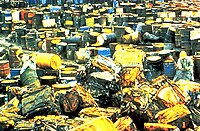
Photo from wikipedia
Drinking water quality of surface and underground water within 1.34 km from a waste landfill site in Kumasi, Ghana was investigated. Physico‐chemical properties and heavy metal concentrations were analysed to… Click to show full abstract
Drinking water quality of surface and underground water within 1.34 km from a waste landfill site in Kumasi, Ghana was investigated. Physico‐chemical properties and heavy metal concentrations were analysed to determine water quality and pollution indices. It was found that turbidity of 83% of hand dug wells, 50% of the streams and 33% of boreholes were higher than World Health Organisation (WHO) standards for drinking water. Water quality index (WQI) showed that 25% of the water sources are of excellent quality, while 50%, 15% and 5% are good quality, poor quality, very poor quality and unsuitable for drinking, respectively. Heavy metal pollution index (HPI) indicated that the water sources were above the critical limit for drinking water (HPI > 100). Principal component analysis (PCA) revealed 75.30% and 70.88% of the total variance for the physico‐chemical parameters and heavy metals, respectively. The findings concluded that cadmium concentrations in all the water sources were extremely higher (0.0122–0.1090 mg/L) than WHO limit (0.003 mg/L), rendering them unwholesome for consumption.
Journal Title: Water and Environment Journal
Year Published: 2020
Link to full text (if available)
Share on Social Media: Sign Up to like & get
recommendations!